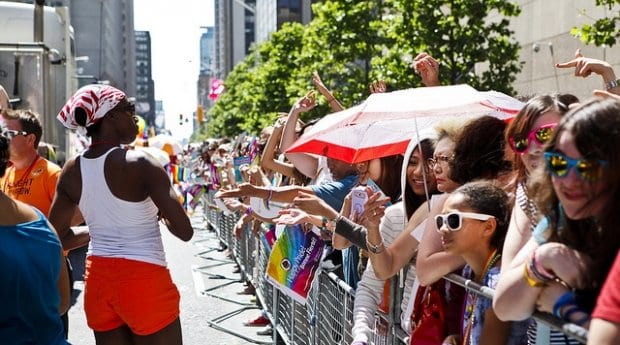A decision by Pride Toronto has limited media access to today’s Pride parade.
In an email sent to all accredited media June 28, just a day before the parade, media were informed that, because of security concerns and the anticipated size of the June 29 event, they would not be granted unrestricted access to the parade route.
A follow-up email sent June 29 clarified that media would be restricted to a number of “media pens” stationed along Yonge and Church streets.
While WorldPride officials initially prohibited interviews along the route, an additional media area was later added on Bloor Street where media will be able to interview marchers before they make their way down the main thoroughfare of Yonge Street.
Kevin Beaulieu tells Xtra the plan was put in place to ensure the parade moves safely and in a timely manner.
“Even small delays cause gaps and bunches in the route,” he says. Because this year’s parade is much larger than last year’s — more than 12,000 people are scheduled to march — organizers want to minimize any delays. In past years, interviews and large numbers of photographers in one place have caused interruptions, Beaulieu says.
This decision is in keeping with past Pride parade policy, according to Beaulieu, who says Toronto Police Service will have the final say on the ground to ensure the parade keeps moving safely. But according to Frank Prendergast, a supervising producer at Daily Xtra publisher Pink Triangle Press, Pride Toronto’s decision is unprecedented.
“In past years, we have covered the parade route from inside,” he says. “There has never been an incident with regards to us being in the parade safety-wise.”
Prendergast has covered the Toronto parade for the last six years and has covered several international Pride parades, including WorldPride in London, England, in 2012. He says Pride parades are still important moments of free expression, and it’s important to capture the participants’ statements, as well as their presence.
Unfettered media access is also essential to capturing the more spontaneous moments that happen along the lengthy parade route, Prendergast adds. “The interaction between the crowds and the marchers is very important for us to capture on video,” he says. “What happens if there is some sort of incident where people are being heckled or threatened?”
The same goes for photographers. Matt Klopot is a freelance photographer for My Gay Toronto and has covered Pride for the last four years. Like Prendergast, he has never had an problem accessing the parade route to take photos.
But on June 29, he was informed that not only could he not access the route, but that his media pass would not grant him access to any of the media pens.
“I make money from the best shots,” he says. He fears that without access to the parade, he won’t be able to take photos that he’ll be able to sell.


 Why you can trust Xtra
Why you can trust Xtra


